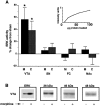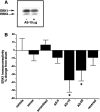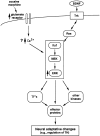Regulation of ERK (extracellular signal regulated kinase), part of the neurotrophin signal transduction cascade, in the rat mesolimbic dopamine system by chronic exposure to morphine or cocaine
- PMID: 8764658
- PMCID: PMC6579030
- DOI: 10.1523/JNEUROSCI.16-15-04707.1996
Regulation of ERK (extracellular signal regulated kinase), part of the neurotrophin signal transduction cascade, in the rat mesolimbic dopamine system by chronic exposure to morphine or cocaine
Abstract
Local infusion of brain-derived neurotrophic factor (BDNF) into the ventral tegmental area (VTA) can prevent and reverse the ability of chronic morphine or cocaine exposure to induce tyrosine hydroxylase (TH) in this brain region. The present study examined a possible role for extracellular signal regulated kinases (ERKs), the major effector for BDNF and related neurotrophins, in morphine and cocaine action in the VTA. Chronic, but not acute, administration of morphine or cocaine increased ERK catalytic activity specifically in the VTA. This increase in ERK activity reflected an increase in the state of phosphorylation of ERK, with no change in levels of total ERK immunoreactivity. Chronic infusions of BDNF into the VTA reduced total ERK immunoreactivity with no change in ERK activity, and also blocked the morphine-induced increase in ERK activity. These results suggest that chronic BDNF elicits a compensatory increase in the phosphorylation of the remaining ERK molecules and thereby prevents any additional increase in response to drug exposure. Such a role for ERK in morphine action was demnostrated directly by chronically infusing antisense oligonucleotides to ERK1 into the VTA. This treatment selectively reduced levels of ERK1 immunoreactivity in a sequence-specific manner without detectable toxicity. Intra-VTA infusion of ERK1 antisense oligonucleotides mimicked the effects of chronic BDNF infusions on ERK immunoreactivity, ERK activity, and TH immunoreactivity in the VTA under both control and morphine-treated conditions. The chronic morphine-induced increases in ERK activity and TH expression in the VTA also were blocked by local infusion of NMDA glutamate receptor antagonists, suggesting a role for glutamate in mediating these drug effects. Together, these findings support a scheme whereby chronic, systemic administration of morphine or cocaine leads to a sustained increase in ERK phosphorylation state and activity in the VTA, which, in turn, contributes to drug-induced increases in TH, and perhaps other drug-induced adaptations, elicited selectively in this brain region.
Figures






References
-
- Beitner-Johnson D, Nestler EJ. Morphine and cocaine exert common chronic actions on tyrosine hydroxylase in dopaminergic brain reward regions. J Neurochem. 1991;57:344–347. - PubMed
-
- Berhow MT, Russell DS, Terwilliger RZ, Beitner-Johnson D, Self DS, Lindsay RM, Nestler EJ. Influence of neurotrophic factors on morphine- and cocaine-induced biochemical changes in the mesolimbic dopamine system. Neuroscience. 1995;68:969–979. - PubMed
-
- Boulton TG, Yancopoulos GD, Gregory JS, Slaughter C, Moomaw C, Hsu J, Cobb MH. An insulin-stimulated protein kinase similar to yeast kinases involved in cell cycle control. Science. 1990;249:64–67. - PubMed
Publication types
MeSH terms
Substances
Grants and funding
LinkOut - more resources
Full Text Sources
Other Literature Sources
Miscellaneous
